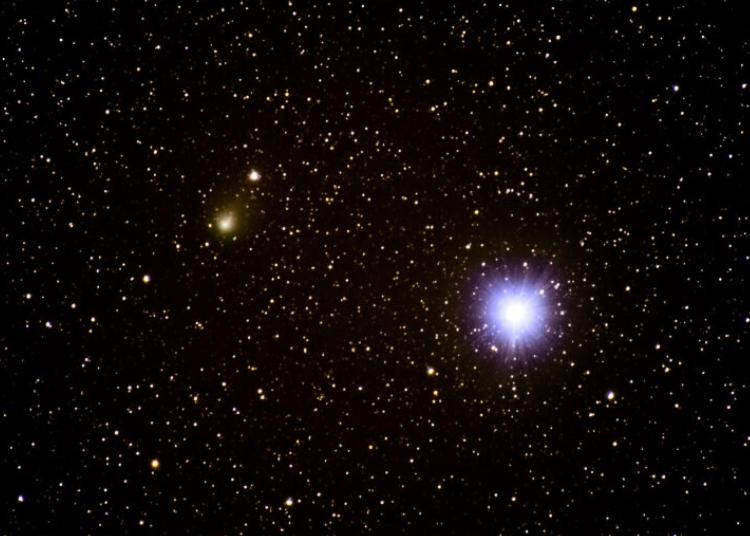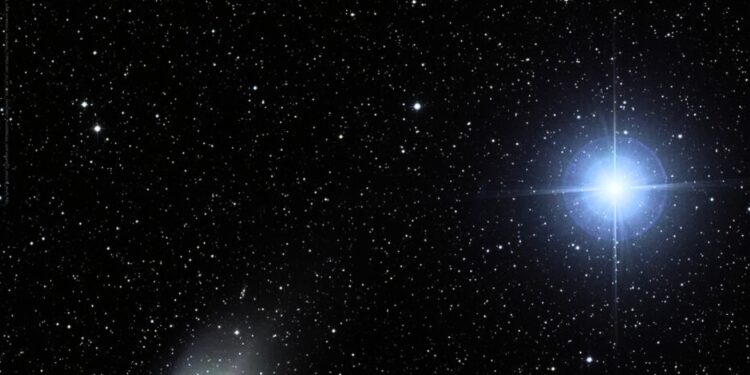A rare and massive comet nicknamed the “devil comet” is set to grace Earth’s skies for the first time in 71 years, according to NASA. This celestial visitor may even be visible during the highly anticipated total solar eclipse happening on April 8th.
The Devilish Details of 12P/Pons-Brooks
Officially named 12P/Pons-Brooks, this comet is classified as cryovolcanic due to its icy eruptions. These eruptions are responsible for the comet’s distinctive feature – two “horns” composed of ice and gas. The horns are not permanent features, but rather the result of outbursts that eject dust and gas from the comet’s nucleus. These outbursts are thought to be caused by pockets of trapped gas or ice erupting from beneath the comet’s surface, similar to eruptions on icy worlds like Pluto.
Glowing with Opportunity During the Eclipse
Comets are cosmic leftovers from the formation of our solar system, composed of dust, frozen gases, ice, and rocks. The devil comet is expected to reach its peak brightness, known as perihelion, on April 21st. This conveniently coincides with the total solar eclipse happening across parts of North America on April 8th. During the brief period of totality, when the moon completely blocks the sun, the darkened sky may provide a perfect opportunity to glimpse 12P/Pons-Brooks.
“NASA says skywatchers will have a view of the vast sky, dark enough to observe stars, planets and perhaps 12P/Pons-Brooks as it travels through the solar system,” the agency reported.

A Second Chance Encounter
Following its perihelion passage, 12P/Pons-Brooks will make its closest approach to Earth on June 2nd. While this might offer another opportunity to see the devil comet, experts warn that its distance from the sun will make it fainter compared to its appearance during the eclipse. However, for skywatchers with telescopes, June 2nd might be a better chance to observe the comet’s physical characteristics in more detail.
A Comet on a Short Leash
12P/Pons-Brooks is classified as a short-period comet, meaning it completes its orbit around the sun in less than 200 years. In this case, the devil comet takes 71 years to make a complete trip around our solar system, with its last visit occurring in 1954. Scientists estimate the comet’s diameter to be at least 17 kilometers (10.5 miles), making it a relatively large comet compared to others.
Outbursts Light Up the Night Sky
The devil comet is known for its periodic outbursts, which can significantly increase its brightness. These outbursts can transform the comet from a faint object only visible with powerful telescopes to something potentially observable with the naked eye from your backyard.
In fact, 12P/Pons-Brooks experienced a major outburst in July 2023, briefly becoming 100 times brighter. This active comet continued to exhibit outbursts on several occasions throughout the latter half of 2023.
“These outbursts … have brought this object from being dim enough that you can only really see it with big professional telescopes to, in a couple of cases, something people can see from their backyard,” Dr. Theodore Kareta, a postdoctoral researcher at Lowell Observatory, told ABC News.
The cause of these outbursts is still being debated by astronomers. Some theories suggest that they might be caused by collisions between icy bodies within the comet, while others propose that they could be the result of fractures in the comet’s icy crust, releasing trapped gases and dust.
Don’t Miss This Cosmic Spectacle
Dr. Eliot Herman, a retired astronomy professor and avid amateur astronomer, encourages everyone to keep an eye out for the devil comet in the coming months.
“People have historically looked up at the sky since people first became self-aware, and being amazed at the events that occur above us is something that goes back far before civilization,” Herman told ABC News. “The events in the sky touch all, I think, in a very historic way. The universe is a big place and a lot of amazing things are occurring all around us. It’s worth getting out there and just looking at it and be awestruck.”
The appearance of the devil comet is a chance for skywatchers to witness a unique and active celestial object. With a little planning and guidance, you might even be able to catch a glimpse of this visitor from the distant past during the April eclipse or throughout the coming months.



















